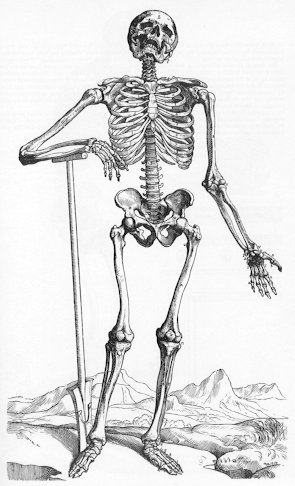Another Look at the Plague
Today, population reduction by disaster. The University of Houston's College of Engineering presents this series about the machines that make our civilization run, and the people whose ingenuity created them.
How many times have you heard someone talk about the good effects of natural disaster on human overpopulation? Well, it happened once. The population of Europe had roughly doubled in the four hundred years leading up to the year AD 1300. An agricultural revolution, coupled with general warming, fed a huge population expansion.
Then famine entered overpopulated Europe. Between 1315 and 1317 torrential rains destroyed crops. As hunger and death stalked the land, people were driven to cannibalism. They even opened graves to claim the newly dead for food.
It's an old story. Good times increase population until it has little capacity to withstand bad times. But this time famine was only the beginning. In AD 1347 Tatars attacked a group of European merchants in a town in the Crimea. The attacking Tatars were suffering from an epidemic. Too sick to press their siege, they used their trebuchets to hurl their own dead over the city walls.
That primitive germ warfare was devastatingly successful. The merchants went back to Genoa with a disease called yersinia pestis. Rats followed them off their ship carrying fleas. The fleas in turn carried the plague that we call The Black Death into Italy.
Plague deaths were uneven, but staggering. Cities like Zürich and Siena lost two-thirds of their people. Forty percent of Europe's population died in a few years' time. Countless villages vanished from maps and from history. Aerial reconnaissance makes it easy to see where medieval villages once were. Over two thousand such ghost villages have been spotted in England -- small compared with Germany, where some 40,000 villages disappeared after 1300.
So historian Jean Gimpel asks what lay in the wake of all this death. Wages skyrocketed, and that in turn led to a new egalitarianism. England's Peasant's Revolt in the 1380s was only one of many such uprisings throughout Europe, all triggered in part by people who saw new value in their labor. In the short term, lives of the living were improved by the material goods of the dead. But in the long term such massive disruption has to be costly. Real income soon fell below pre-famine and pre-Plague levels.
Worst of all was the long-term social dislocation. If there was a Dark Age in medieval Europe, it might well've been that century after the Plague. The Hundred Years War began ten years before the Plague, and it lasted all the way up to Gutenberg. Whole generations lived lives surrounded not only by one dirty little war after another, but by economic upheaval as well. People like to suggest that disaster is nature's way of improving our lives by controlling population. But a high price attaches to human life. When death occurs on that unprecedented scale, it's small surprise to find survivors spending centuries sorting out the loss.
I'm John Lienhard, at the University of Houston, where we're interested in the way inventive minds work.
(Theme music)
Gimpel, J., The Medieval Machine; The Industrial Revolution of the Middle Ages. New York: Penguin Books.
Huppert, G., After the Black Death: A Social History of Early Modern Europe. Bloomington, IN: Indiana University Press, 1986
Gottfried, R. S., The Black Death: Natural and Human Disaster in Medieval Europe. New York: The Free Press, 1983.
McNeill, W. H., Plagues and Peoples. New York: Anchor Book, 1976.
For more on The Black Death, see Episodes 123 and 1037.

from Vesalius, De Humani Corporis Fabrica, 1543